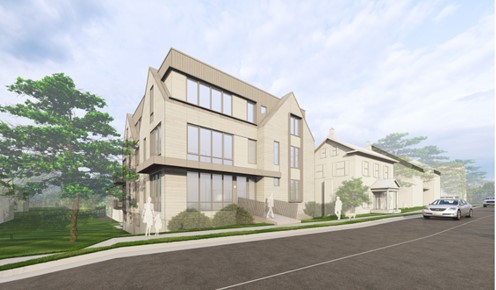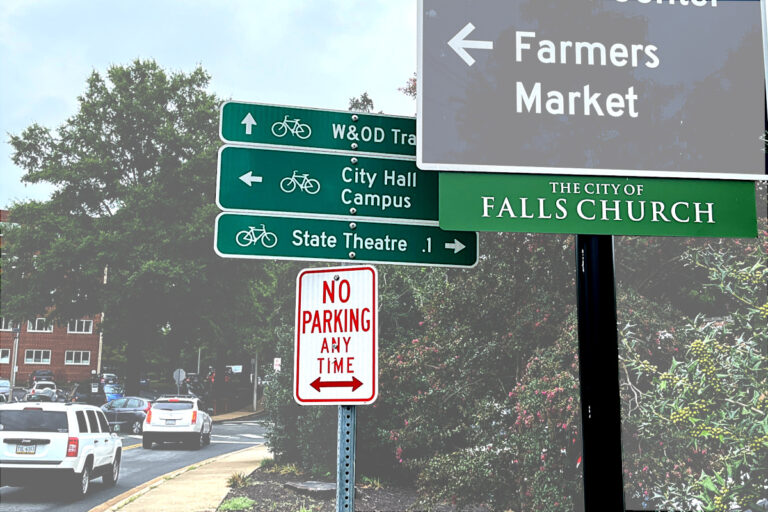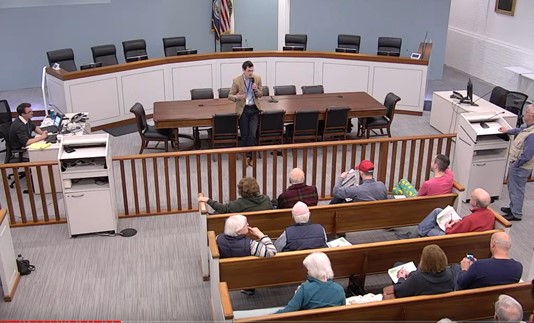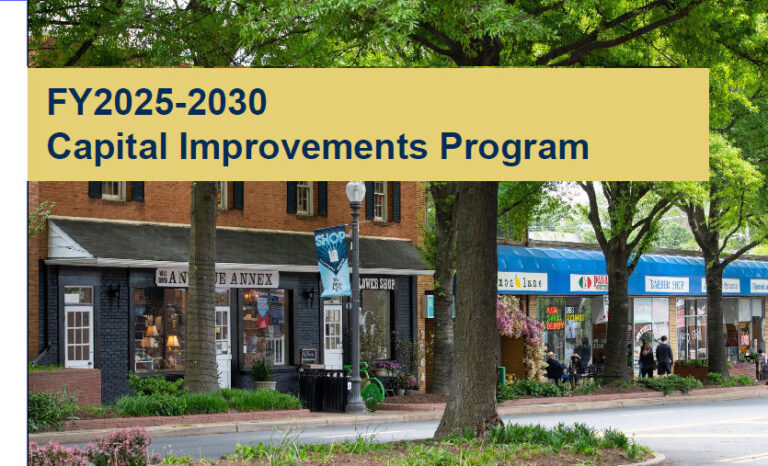Council Reviews Draft Affordable Living Policy’s 20 Goals
Summary
- The City Council provided feedback on a draft Affordable Living Policy (ALP) that, once approved, will become part of the City’s Comprehensive Plan. The Council was uniformly appreciative of the work the staff and the workgroup have put into crafting this policy.
- The ALP’s eight priorities out of a total of 20 goals include:
- securing more affordable units in new development and providing more affordable units to residents at or below 60% of the Area Media Income (AMI) for a household of four;
- retaining the City’s current stock of affordable units;
- broadening the types of housing available in Falls Church, including units with two or more bedrooms;
- expanding housing and services to people with no or little income (0-30% AMI); and
- securing dedicated, annual, and indexed funding for housing.
- The draft plan links housing to zoning and development, advocating “missing middle” housing and “streamlining development requirements, including reduced parking, minimizing setbacks, and increasing density to promote City goals.”
- Council feedback included:
- requiring that 12% of all units in new developments be affordable;
- increasing the percentage of “deeply affordable” units (30-50% AMI) to 25% of all affordable units;
- considering the impact of the plan’s goals on the schools;
- including in all strategies associated with density references to the City’s environmental and infrastructure requirements;
- providing with all recommended investments to achieve plan goals a sense of the size of those investments and the additional context and caveat of the need to manage budgets and address current economic conditions; and
- ensuring that the entire community is fully aware of what the plan encompasses.
- The plan next goes to the Planning Commission for its further review and recommendations and then back to the City Council for final review and adoption in August.
A five-year update
Dana Jones, director of Housing & Human Services, presented the draft plan to the City Council at its May 19, 2025, work session, with the goal of seeking Council feedback. She was accompanied by Brenden Woodley, City housing development specialist; Jeff Person, co-chair of the Affordable Living Policy Workgroup; and Brian Bowden, chair of the Human Services Advisory Council.
Ms. Jones explained that the Affordable Living Policy (ALP) is updated every five years and, with this update, will become part of the City’s Comprehensive Plan for the first time as a sub-chapter of “Chapter 10: Housing a Complete Community.” “We’ve had this policy before, but it didn’t really have a lot of teeth,” she said.
Also new with this update will be a housing dashboard to track the City’s progress against the plan. The dashboard will be created and made available to the public once the Council approves the plan, anticipated by mid-August.
The workgroup met eight times and represented a cross-section of the community. “We had renters and homeowners of all different races. We had school employees, business owners, developers, mortgage lenders—a really great group of folks,” Ms. Jones said. The resulting program “is intended to provide something for everyone.”
City Council members all expressed support for the ALP and appreciation for the work that has gone into drafting this update.
Priority goals and strategies
The Housing & Human Services Director began her presentation by noting that no more than 30% of income should be spent on housing, and that the median annual income for a household of four people in the City is $154,700.
| Income Category | Income Range for a Household of Four | % of Area Median Income (AMI) |
| Low income | $46,000-$77,000 | 30-50% |
| Moderate income | $78,000-$123,000 | 51-80% |
| High income | $124,000-$185,000 | 81-110% |
The 40-page draft, titled “The Affordable Living Policy: A Blueprint For An Equitable & Inclusive City for All,”lists 20 goals, associated strategies, and estimated timelines and costs, including staffing. A complete list of the seven plan elements – rental housing, homeownership, preservation, housing stock, unhoused and wraparound services, funding, and governance – and their goals and strategies can be found in the draft policy and in a summary document assembled from the report by the Pulse.
Eight of the 20 goals are designated priorities as follows:
- Increase the percentage of affordable units in new development to a minimum of 12%; up from the 2019 Affordable Living Policy that encouraged greater than 6%. [Goal 1 under rental housing.]
- Increase the ratio of affordable units (at and below 60% AMI) of total housing stock from 3% to 6% by 2040. [Goal 2 under rental housing.]
- Retain the affordability of existing committed affordable units or achieve zero net-loss due to affordability expirations with offsite replacements as needed. [Goal 6 under preservation.]
- Ensure adequate stock along the housing spectrum from single-family dwelling units, to townhomes, duplexes, and multifamily units. [Goal 8 under housing stock.]
- Encourage larger household units (2+ bedrooms) in multifamily properties. [Goal 9 under housing stock.]
- Expand housing and service options for persons with incomes at 0-30% AMI and persons with disabilities. [Goal 11 under unhoused and wraparound services.]
- Retain or expand unhoused services at the Property Yard. [Goal 12 under unhoused and wraparound services.]
- Secure a dedicated, annual, and indexed source of funding. [Goal 15 under funding.]
Highlights from the draft ALP and Council feedback
Ms. Jones characterized the first goal that would increase to a minimum of 12% the number of affordable units in new development as “a stretch goal,” noting that this “may not happen.” However, Council Member Erin Flynn said that she did not consider this a stretch goal. “If you’re coming [to the City] and you’re doing new development, you should be at 12%,” adding that this percentage of affordable units “should be non-negotiable.”
Noting that the City will have 99 new affordable dwelling units (ADUs) by the end of 2026 along with 12 City committed affordable units (CCAUs), Ms. Jones observed that residents with incomes at 30-50% AMI “are a big part of our waiting list” of some 700 households. In response, Mayor Letty Hardi encouraged the ALP workgroup to prioritize the third goal of the plan’s rental housing section to increase the percentage of deeply affordable units to 25% of the total number of affordable units in the City. “I think [providing housing for] below 50% AMI is important to really serve the needs of this population,” she said.
Ms. Flynn added the importance of clearly identifying the magnitude of some of the investments the draft ALP proposes to achieve its stated goals. “Some of the percentages downplay what a stretch it will be to meet some of these goals, given budget constraints,” she said.
Affordable homeownership and rents in Falls Church
The City has made “great strides” with its Affordable Home Ownership Program, Ms. Jones reported. “We had not had any new units since 2008” when eight units at The Spectrum multifamily development were designated affordable. But a grant from Amazon in the last three years rebooted this program, enabling the purchase of 10 homes in the City. The staff’s goal is to add another 10 properties to this list. “We’re pretty excited about that, because the median home price right now is $1.3 million. These [homeowners] are school and City employees, and they definitely would not have had this opportunity without this program,” she said.
City staff and the Council are focused on either retaining or achieving zero net loss of existing committed affordable rental units due to the expiration of affordability requirements. Ms. Jones noted that 96 affordable units at The Fields and 15 units at Pearson Square are currently set to expire in 2027, with additional affordable units at the Read Building, Northgate, Lincoln at Tinner Hill, and the West Broad Residences scheduled to expire between 2032 and 2035. Ms. Jones confirmed that newer multifamily developments do not have such expiration dates.
Bigger units, increased density
Priority goals around providing additional housing stock “along the housing spectrum” and encouraging larger household units in multifamily properties generated considerable comment from Council members. Strategies to achieve the ALP’s housing stock goals include reference to “missing middle” housing and “streamlining development requirements, including reduced parking, minimizing setbacks, and increasing density to promote City goals.” Ms. Jones said staff believes that the new accessory dwellings ordinance and changes in 2023 to transition zoning “will help affordability in the long run.”
Ms. Flynn commented that the conversation regarding this policy “isn’t necessarily a missing middle conversation; this is about how we fund committed affordable housing units,” extend current affordable units such as those at Pearson Square and other buildings, and ensure “that people who are in our community are able to stay in our community.”
Council Member Laura Downs cautioned that when inviting such increased density, she “wants to make sure the impact on the schools is considered.” Council Member David Snyder seconded Ms. Downs’ concern and urged that strategies associated with density be consistent with the City’s environmental and infrastructure requirements. He asked that consideration for these objectives be added to the ALP.
Renting a room
In addressing goals to assist people experiencing homelessness and provide them with additional services, Ms. Jones said, “We really need single resident occupancy units where a person can rent a room,” and noted that the City’s homeless shelter is currently able to serve only 10 adult males and two adult females for the five coldest months of the year. The workgroup recommended increasing these services and examining whether additional housing and services might be provided to more than the five people with intellectual disabilities the City now serves.
Funding housing initiatives
Regarding funding, the draft ALP seeks dedicated, annual, and indexed funding, and references a target annual amount of $1.65 million by 2040. “This year, we have a six-year affordable housing fund that runs concurrently with the [City’s Capital Improvements Program],” Ms. Jones said. “This is the result of the City Council adopting new fiscal policies that will allow us to do some long-term planning for [investments] we see on the horizon—especially the preservation of affordable units.”
The plan compares spending by neighboring jurisdictions Alexandria and Arlington with that of Falls Church. To bring the City’s per capita affordable housing funding in parity with neighboring jurisdictions, the City would have to more than double current investment per capita from $34 to $80, according to the ALP.
Council Member Snyder cautioned that “the comparison to Alexandria and Arlington tends to downgrade the commitment that we have all made here and the progress achieved so far.” He noted that both of these jurisdictions have a much lower tax rate than the City does—“and for good reason:” Arlington has Crystal City, which has been reinvigorated by Amazon HQ2, and Alexandria was essentially given the Potomac freight yard for redevelopment.
Mr. Snyder questioned the draft policy’s reference to a firm monetary commitment. “Maybe talk about stretch goals rather than creating the sense that this [funding] will happen, regardless of the overall context in which we are going to have to manage the [City] budget,” he said. “These goals may not be reachable in a particular year.”
Council Member Justine Underhill also noted the need “to be aware of broader budget and economic circumstances.” Council Member Flynn further echoed Mr. Snyder’s comments, noting that while the draft document sets forth affordability goals, “we are a small jurisdiction.” She added that she doesn’t want to get too far ahead of the community.
In the ALP’s references to tax abatements and the goal of enabling senior citizens to age in place, Ms. Flynn said, “It is important that we [include] tax relief and a recognition of the need to reduce the tax burden on residents generally.” This plan “should be viewed as a toolkit that we will employ whenever we can as best we can.”
Greater public involvement in planning for housing
Where governance is concerned, the proposed policy emphasizes the need for partnerships with a wide range of organizations from faith-based institutions to developers to achieve housing goals as well as greater public involvement in planning for housing, Ms. Jones stated.
To that end, Mr. Snyder said he is not sure that citizens beyond the City’s boards and commissions are aware of the ALP. He asked the staff and the workgroup to find ways between now and formal action by the Council in August—perhaps through town halls, emailed Focus on Falls Church newsletter, and other City publications—“to make sure the entire community is very much aware of this [plan] and supportive of it. The more support, the broader the support, the more effective we’re going to be” in reaching these goals.
Vice Mayor Debora Schantz-Hiscott said that she expects the planned dashboard “will be a great way to make data accessible to the community as a whole,” though it won’t be implemented until after the City Council approves the plan.
Asked by Council Member Underhill whether once approved the plan will be binding, City Attorney Sally Gillette said that as part of the Comprehensive Plan the final ALP would serve as guidance for development when a developer is seeking zoning approval. “It is not binding regulation,” she said. Mr. Snyder suggested adding a paragraph to the ALP that describes “what the Comprehensive Plan is and what it isn’t.”
The current schedule for acting on the draft includes the Council’s referral of the ALP to the Planning Commission by June 9, 2025; a Planning Commission work session on June 18, followed by that body’s formal recommendations and a public hearing on July 16; a final Council work session on August 4; and Council’s public hearing and second reading and adoption on August 11.
References
- City Council work session, May 19, 2025. Discussion of Affordable Living Policy begins at timestamp 2:40 and ends at timestamp 53:27. This official video will not display properly on a small screen as it includes the agenda.
- City Council work session, May 19, 2025. YouTube video.
- Affordable Living Policy (ALP) Referral Work Session Staff Report, May 19, 2025.
- The Affordable Living Policy: A Blueprint For An Equitable & Inclusive City For All, draft as of May 19, 2025.
- ALP Referring Presentation, May 19, 2025.
- Comments shared by the City Council, the Affordable Living Policy Work Group, the Housing Commission, the Human Services Advisory Council, the Planning Commission, and the Economic Development Authority members prior to the May 19, 2025, City Council work session.







